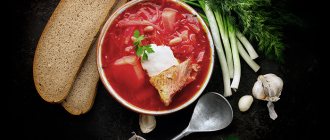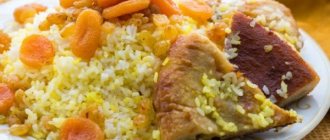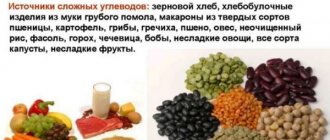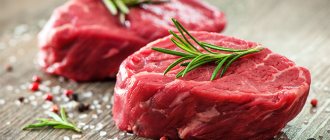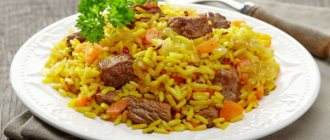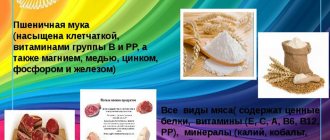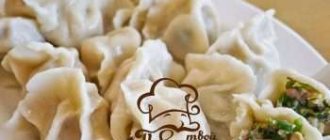Borscht is one of the most popular first courses in Slavic cuisine. In Rus', borscht has been known for many centuries; sayings and proverbs are dedicated to it. And there is nothing surprising about this. After all, the traditional recipe for red soup includes only natural ingredients that are beneficial to the human body. This is a perfectly balanced and satisfying first course that can cover your daily energy requirement. But does it allow you to lose weight? What is the calorie content of borscht prepared according to different recipes?
Calorie content of borscht with beef
Most often, a hearty and nutritious soup for the whole family is prepared with beef (on the bone or with fillet). What is the energy value of classic borscht? Calculating the calorie content of the first course per 100 grams, we get 50.1 kcal. The BJU of such a soup, which is prepared by cooking without draining, is:
- proteins - 3.9 g;
- fats - 2.5 g;
- carbohydrates - 3.1 g.
Considering that the traditional portion served in a deep plate is 250 grams, 1 plate contains 125.3 kcal. At the same time, BZHU is presented in 9.8/6.3/7.8 g, respectively.
If you use fresh cabbage instead of sauerkraut to prepare borscht, the energy value and other indicators will be higher.
Recipe for Borscht with beef. Calorie, chemical composition and nutritional value.
Nutritional value and chemical composition of “Borscht with beef”.
The table shows the nutritional content (calories, proteins, fats, carbohydrates, vitamins and minerals) per 100 grams of edible portion.
| Nutrient | Quantity | Norm** | % of the norm in 100 g | % of the norm in 100 kcal | 100% normal |
| Calorie content | 50.1 kcal | 1684 kcal | 3% | 6% | 3361 g |
| Squirrels | 3.9 g | 76 g | 5.1% | 10.2% | 1949 |
| Fats | 2.5 g | 56 g | 4.5% | 9% | 2240 g |
| Carbohydrates | 3.1 g | 219 g | 1.4% | 2.8% | 7065 g |
| Organic acids | 0.1 g | ~ | |||
| Alimentary fiber | 0.6 g | 20 g | 3% | 6% | 3333 g |
| Water | 89.1 g | 2273 g | 3.9% | 7.8% | 2551 g |
| Ash | 0.735 g | ~ | |||
| Vitamins | |||||
| Vitamin A, RE | 5.3 mcg | 900 mcg | 0.6% | 1.2% | 16981 g |
| beta carotene | 0.032 mg | 5 mg | 0.6% | 1.2% | 15625 g |
| Vitamin B1, thiamine | 0.02 mg | 1.5 mg | 1.3% | 2.6% | 7500 g |
| Vitamin B2, riboflavin | 0.029 mg | 1.8 mg | 1.6% | 3.2% | 6207 g |
| Vitamin B4, choline | 13.99 mg | 500 mg | 2.8% | 5.6% | 3574 g |
| Vitamin B5, pantothenic | 0.145 mg | 5 mg | 2.9% | 5.8% | 3448 g |
| Vitamin B6, pyridoxine | 0.115 mg | 2 mg | 5.8% | 11.6% | 1739 |
| Vitamin B9, folates | 4.305 mcg | 400 mcg | 1.1% | 2.2% | 9292 g |
| Vitamin B12, cobalamin | 0.518 mcg | 3 mcg | 17.3% | 34.5% | 579 g |
| Vitamin C, ascorbic acid | 2.46 mg | 90 mg | 2.7% | 5.4% | 3659 g |
| Vitamin E, alpha tocopherol, TE | 0.121 mg | 15 mg | 0.8% | 1.6% | 12397 g |
| Vitamin H, biotin | 0.631 mcg | 50 mcg | 1.3% | 2.6% | 7924 g |
| Vitamin K, phylloquinone | 4.5 mcg | 120 mcg | 3.8% | 7.6% | 2667 g |
| Vitamin RR, NE | 1.9223 mg | 20 mg | 9.6% | 19.2% | 1040 g |
| Niacin | 0.726 mg | ~ | |||
| Macronutrients | |||||
| Potassium, K | 141.73 mg | 2500 mg | 5.7% | 11.4% | 1764 g |
| Calcium, Ca | 15.28 mg | 1000 mg | 1.5% | 3% | 6545 g |
| Magnesium, Mg | 9.87 mg | 400 mg | 2.5% | 5% | 4053 g |
| Sodium, Na | 225.16 mg | 1300 mg | 17.3% | 34.5% | 577 g |
| Sera, S | 52.03 mg | 1000 mg | 5.2% | 10.4% | 1922 |
| Phosphorus, P | 39.1 mg | 800 mg | 4.9% | 9.8% | 2046 g |
| Chlorine, Cl | 246.46 mg | 2300 mg | 10.7% | 21.4% | 933 g |
| Microelements | |||||
| Aluminium, Al | 96.1 mcg | ~ | |||
| Bor, B | 42.4 mcg | ~ | |||
| Vanadium, V | 22.57 mcg | ~ | |||
| Iron, Fe | 0.728 mg | 18 mg | 4% | 8% | 2473 g |
| Yod, I | 2.69 mcg | 150 mcg | 1.8% | 3.6% | 5576 g |
| Cobalt, Co | 2.253 mcg | 10 mcg | 22.5% | 44.9% | 444 g |
| Lithium, Li | 8.057 mcg | ~ | |||
| Manganese, Mn | 0.1002 mg | 2 mg | 5% | 10% | 1996 |
| Copper, Cu | 67.93 mcg | 1000 mcg | 6.8% | 13.6% | 1472 g |
| Molybdenum, Mo | 4.606 mcg | 70 mcg | 6.6% | 13.2% | 1520 g |
| Nickel, Ni | 3.67 mcg | ~ | |||
| Tin, Sn | 15.09 mcg | ~ | |||
| Rubidium, Rb | 103.4 mcg | ~ | |||
| Selenium, Se | 0.033 µg | 55 mcg | 0.1% | 0.2% | 166667 g |
| Fluorine, F | 77.86 mcg | 4000 mcg | 1.9% | 3.8% | 5137 g |
| Chromium, Cr | 4.71 mcg | 50 mcg | 9.4% | 18.8% | 1062 g |
| Zinc, Zn | 0.7451 mg | 12 mg | 6.2% | 12.4% | 1611 g |
| Digestible carbohydrates | |||||
| Starch and dextrins | 1.512 g | ~ | |||
| Mono- and disaccharides (sugars) | 1.7 g | max 100 g | |||
| Glucose (dextrose) | 0.109 g | ~ | |||
| Sucrose | 1.001 g | ~ | |||
| Fructose | 0.035 g | ~ | |||
| Essential amino acids | 0.12 g | ~ | |||
| Arginine* | 0.227 g | ~ | |||
| Valin | 0.224 g | ~ | |||
| Histidine* | 0.146 g | ~ | |||
| Isoleucine | 0.171 g | ~ | |||
| Leucine | 0.316 g | ~ | |||
| Lysine | 0.341 g | ~ | |||
| Methionine | 0.095 g | ~ | |||
| Methionine + Cysteine | 0.149 g | ~ | |||
| Threonine | 0.175 g | ~ | |||
| Tryptophan | 0.046 g | ~ | |||
| Phenylalanine | 0.175 g | ~ | |||
| Phenylalanine+Tyrosine | 0.32 g | ~ | |||
| Nonessential amino acids | 0.225 g | ~ | |||
| Alanin | 0.232 g | ~ | |||
| Aspartic acid | 0.412 g | ~ | |||
| Hydroxyproline | 0.058 g | ~ | |||
| Glycine | 0.202 g | ~ | |||
| Glutamic acid | 0.669 g | ~ | |||
| Proline | 0.152 g | ~ | |||
| Serin | 0.175 g | ~ | |||
| Tyrosine | 0.146 g | ~ | |||
| Cysteine | 0.056 g | ~ | |||
| Sterols (sterols) | |||||
| Cholesterol | 15.94 mg | max 300 mg | |||
| Saturated fatty acids | |||||
| Saturated fatty acids | 1.4 g | max 18.7 g | |||
| 14:0 Miristinovaya | 0.11 g | ~ | |||
| 15:0 Pentadecane | 0.02 g | ~ | |||
| 16:0 Palmitinaya | 0.841 g | ~ | |||
| 17:0 Margarine | 0.052 g | ~ | |||
| 18:0 Stearic | 0.406 g | ~ | |||
| Monounsaturated fatty acids | 1.496 g | min 16.8 g | 8.9% | 17.8% | |
| 14:1 Myristoleic | 0.05 g | ~ | |||
| 16:1 Palmitoleic | 0.182 g | ~ | |||
| 18:1 Oleic (omega-9) | 1.264 g | ~ | |||
| Polyunsaturated fatty acids | 0.12 g | from 11.2 to 20.6 g | 1.1% | 2.2% | |
| 18:2 Linolevaya | 0.088 g | ~ | |||
| 18:3 Linolenic | 0.036 g | ~ | |||
| 20:4 Arachidonic | 0.004 g | ~ | |||
| Omega-6 fatty acids | 0.1 g | from 4.7 to 16.8 g | 2.1% | 4.2% |
The energy value of Borscht with beef is 50.1 kcal.
Primary Source: Created in the application by the user. Read more.
** This table shows the average levels of vitamins and minerals for an adult. If you want to know the norms taking into account your gender, age and other factors, then use the “My Healthy Diet” application.
Calorie content of borscht with chicken
Less often (but this interpretation also occurs) borscht is cooked with turkey or chicken. It contains a standard set of ingredients. The only exception is meat - usually chicken breast. This option without frying gives only 28.4 kcal per 100 grams of the finished dish. The BJU in borscht with chicken broth will be as follows:
- proteins - 1.9 g;
- fats - 0.4 g;
- carbohydrates - 4.4 g.
The energy and nutritional value of the soup will increase if you use chicken with skin. But refusing to add potatoes will reduce these indicators.
ABC RECOMMENDS
Calorie content of boiled, fried, baked chicken: table per 100 grams
How to cook lean borscht?
This cooking method is suitable for those who observe religious fasts, as well as those who are on a therapeutic or dietary diet.
Ingredients:
- 300 gr. white cabbage;
- 150 gr. carrots;
- 200 gr. onions;
- 100 gr. beets;
- 250 gr. potatoes;
- 30 gr. greenery;
- 2-3 cloves of garlic;
- vegetable oil;
- 2 liters of water.
Preparation:
- Boil water in a saucepan, add salt to taste.
- Separately, boil the beets in advance, cool and grate on a coarse grater.
- Finely chop the onion and fry in sunflower oil over medium heat for 6 minutes. Add finely grated carrots to it, fry, stirring for another 5 minutes.
- Place finely shredded cabbage in boiling water.
- Cut the potatoes into small cubes and add to the soup 20 minutes after the cabbage. After 10 minutes, add beets and fried vegetables. Turn off and leave with the lid closed.
- Greens and garlic are added to portions as desired.
In every home, this dish can be prepared in completely different ways: some cook it in meat broth, adding legumes, while others like a lean version made from stewed vegetables. But one thing in borscht always remains the same - beets, which give aroma, taste and rich color to this soup.
Calorie content of borscht with sour cream
Traditionally serving borscht at the table involves adding sour cream. But keep in mind: on average 1 tbsp. A spoonful of sauce adds another 25 units to the standard calorie content of the dish. It turns out that if the energy value of homemade soup prepared with beef broth is 50 units, then a serving of borscht with a spoonful of sour cream comes out to 75 kcal.
Photo source: shutterstock.com
What is the BJU of such a first course? Of course, it can be prepared in different ways, and this ratio depends on the selected components. But if you cook borscht according to the classic recipe and add 1 tbsp per 100 g. l. sour cream, then the output can be 5.1 g of carbohydrates, 3.6 g of fat and 4.2 g of protein.
If you use mayonnaise rather than sour cream as a dressing for borscht, then the calorie content of even the lean version will be higher.
Calorie analysis
The caloric content of soup is affected by foods. The table provides a list of ingredients (in the amount required, on average, for borscht) with calorie content.
Beef borscht, whose calorie content depends on the chemical composition of the products, becomes more nutritious if some of the ingredients are fried.
| Component | Weight, g | Kcal |
| Beef | 400 | 551 |
| White cabbage | 200 | 52 |
| Carrot | 60 | 20 |
| Onion | 50 | 19 |
| Potato | 150 | 108 |
| Beet | 200 | 78 |
| Tomato | 100 | 22 |
| Spinach | 150 | 33 |
| Sorrel | 150 | 31 |
| Salt | 15 | — |
| Ground black pepper | 5 | 12 |
| Water | 2000 | — |
| Sauerkraut | 200 | 46 |
| Beet tops | 150 | 41 |
| Garlic | 20 | 30 |
| Vegetable oil | 30 (for sautéing vegetables) | 270 |
| Chicken egg | 30 (1/2 egg per serving) | 47 |
| Mayonnaise (67%) | 25 (1 tbsp.) | 157 |
| Sour cream (15%) | 20 (1 tbsp.) | 32 |
Composition and nutritional value of borscht
What valuable substances are included in this beloved soup? The nutritional value of red and green borscht is explained by the fact that it contains:
- dietary fiber;
- iron;
- vitamin B6;
- potassium;
- zinc;
- biotin;
- vanadium;
- vitamin PP;
- iodine;
- vitamin D;
- sodium.
It also contains ascorbic acid, vitamin B12, calcium, vitamins A and E, lithium, sulfur, chlorine, tin, fluorine and many other valuable microelements and nutrients.
Composition of nutrients, BJU
Lenten vegetarian borscht on water without meat
| For quantity: 100 grams | ||
| Calories — 28 | Calories from fat - 12 | |
| BJU | ||
| Total fat content | 1.32g | |
| Saturated | 0.15g | |
| Polyunsaturated | 0.47g | |
| Monounsaturated | 0.65g | |
| Cholesterol | 0mg | |
| Total carbohydrate content | 3.8g | |
| Dietary fiber | 0.82g | |
| Sugar | 1.25g | |
| Squirrels | 0.63g | |
| Vitamins and microelements | ||
| A - 43.59 µg | C - 36.87 mg | |
| B-6 – 0.08 mg | B-12 - 0.06mcg | |
| D - 0mcg | E - 0.63 mg | |
| Calcium 17mcg | Iron 0.35mg | |
| Magnesium 9.31 mg | Zinc 0.12mg | |
| Potassium 131 mg | Sodium 19 mg | |
Distribution of calories for BJU:Carbohydrates (49%) Fats (42%) Proteins (9%) | ||
Daily intake of borscht
How much borscht can you eat every day? The exact amount depends on the person's needs and lifestyle. This dish contains most of the valuable vitamins and micronutrients. Therefore, if you wish, you can only eat borscht.
Photo source: shutterstock.com
But here you need to take into account that people employed in heavy production require 4000-5000 kcal per day. If you lead a sedentary lifestyle, then the number of required kilocalories drops to 2500.
Knowing the energy value of a particular type of dish, it will not be difficult to independently calculate the daily intake. For example, if the average calorie content of beef borscht is about 100 kcal per 100 grams, then you can eat a lot of it every day.
The benefits and harms of borscht
What are the beneficial properties of borscht? If we are talking about soup made with meat broth, traditional in Russian and Ukrainian culture, then we can safely talk about its positive properties for the health of adult men and women, as well as children.
Photo source: shutterstock.com
So what is this soup good for our body? The secret of borscht is simple - due to a balanced combination of proteins, enzymes, fats, vitamins, minerals and carbohydrates, the dish is optimal for nutrition. Red borscht (like its green version with sorrel and egg) allows you to:
- normalize the functioning of the gastrointestinal tract;
- improve the functioning of the intestines and stomach;
- provide the body with fiber due to the high content of vegetables;
- strengthen human immunity.
In addition, after heat treatment, vegetables turn into a useful and delicate sorbent, which gently but effectively removes toxins, nitrates, heavy metals, waste and radionuclides from the human body.
Borscht also has a beneficial effect on metabolic processes and promotes weight loss. The substances contained in its composition are involved in the mechanism of hematopoiesis and the prevention of diabetes mellitus.
Photo source: shutterstock.com
But in some cases, borscht may not be harmless at all. When does it harm the body? The danger occurs with certain contraindications:
- pancreatitis;
- cholecystitis;
- kidney diseases, especially during exacerbation.
In addition, carrots and cabbage, which are necessarily included in the recipe, are leaders in the degree of nitrate absorption. Accordingly, they give them to us. To avoid harm from borscht, it is recommended to use only high-quality vegetables, preferably from your own garden.
ABC RECOMMENDS
Boiled potatoes: calorie content, benefits and harms, nutritional value
Borscht with beef in a weight loss diet
Beef borscht is recommended to be consumed during weight loss. Low calorie content and a large supply of valuable substances will contribute to gradual weight loss without causing harm to the body.
BJU of lean beef per 100 g is 28 g, 6.5 g, 0 g, respectively. Due to its high protein content, low fat level, and lack of carbohydrates, beef broth is considered a dietary dish. The high content of microelements allows it to be included in the menu of low-calorie diets.
Vegetables and greens contain large amounts of fiber.
Heat treatment transforms these components into a soft and delicate sorbent that can remove waste and toxins from the body. Borscht helps normalize the digestive system and improves metabolism. To make borscht as dietary as possible, it is recommended to exclude the stage of frying the ingredients.
An alternative would be to heat-treat food in a non-stick frying pan without adding oil. It is important to choose quality ingredients. Nitrates, which may be present in vegetables, will go into the broth during cooking and can harm the body.
Borscht calorie table
To make it easier to navigate the calorie content of various interpretations of this first dish, use the table:
| Borsch | Calorie content per 100 g (kcal) |
| With porcini mushrooms | 20 |
| Siberian | 48 |
| Cold summer | 49 |
| Ukrainian | 49 |
| With sorrel and bulgur | 35 |
| With pork stew | 35,9 |
| With minced chicken and broccoli | 78,8 |
| With chicken in the oven | 47,5 |
| With beans without meat | 65,1 |
| Pork ribs with boiled beans | 67,2 |
Calorie content of lean borscht per 100 grams
For calculation we took:
- 1 g lemon juice;
- 10 g beets;
- 30 g cabbage;
- 25 g onions;
- 15 g carrots;
- 1/2 teaspoon sunflower oil;
- 1 g garlic.
| Name | Weight |
| Calorie content | 19.8 g |
| Fats | 1.1 g |
| Carbohydrates | 2.3 g |
| Squirrels | 0.5 g |
| Vitamin C | 3.7 mg |
